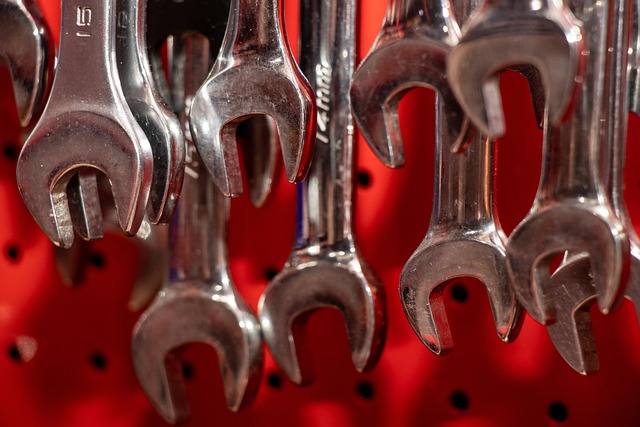Streamlining Heat Damage Auto Body Repairs: Effective Communication Strategies
Heat damage auto body repairs, offered by reputable collision centers, address structural and cosmet…….
In the realm of automotive maintenance and restoration, heat damage auto body repair has emerged as a specialized field, addressing the intricate challenges posed by thermal deterioration on vehicle structures. This comprehensive guide delves into the intricacies of this process, offering insights for professionals and enthusiasts alike. We will explore its historical foundations, global impact, economic implications, technological innovations, regulatory landscape, and future prospects. By the end of this article, readers will have a thorough understanding of heat damage auto body repair, its significance, and its role in shaping the automotive industry’s evolution.
Definition: Heat damage auto body repair refers to the specialized process of restoring and repairing vehicle bodies affected by excessive heat exposure. This can include scenarios such as fire damage, industrial accidents, or prolonged exposure to high temperatures during manufacturing or storage. The primary goal is to not only fix structural defects but also ensure the safety, aesthetics, and longevity of the vehicle.
Core Components:
Assessment and Analysis: The process begins with a thorough inspection and evaluation of the heat-damaged area. This involves non-destructive testing methods like infrared thermography to identify hot spots and determine the extent of thermal degradation.
Structural Repair: Technicians employ various techniques, including metal fabrication, welding, and specialized repair composites, to rebuild and reinforce affected components. The goal is to restore structural integrity while minimizing weight and optimizing strength-to-weight ratio.
Surface Restoration: This involves repainting, refinishing, and detailing to match the vehicle’s original aesthetics. Skilled technicians use advanced paint systems and techniques to achieve a flawless finish, ensuring the car’s exterior looks as good as new.
Safety and Compliance: Ensuring that the repaired vehicle meets safety standards is paramount. Repaired areas undergo rigorous testing to comply with industry regulations, guaranteeing structural integrity and passenger safety.
Historical Context: The concept of heat damage auto body repair has evolved significantly over time. Historically, manual labor and traditional metalworking techniques dominated the field. However, advancements in technology have led to more sophisticated tools and methods. Modern practices incorporate computer-aided design (CAD) for precision measurements, laser technology for precise cutting and welding, and advanced composite materials that mimic the properties of metal while offering lighter weight.
Heat damage auto body repair has a profound global impact, influencing the automotive industry’s recovery and reconstruction efforts across regions. Key trends shaping this field include:
Increasing Frequency of Natural Disasters: Events like wildfires, hurricanes, and floods have risen in frequency and intensity, leading to a surge in heat-damaged vehicle recoveries worldwide. This puts a strain on repair facilities and requires faster turnaround times.
Globalization of Automotive Manufacturing: The global automotive industry’s trend towards shared platforms and modular designs means that vehicles are becoming more uniform worldwide. This facilitates the exchange of parts and knowledge between regions, enhancing the expertise available for heat damage repairs.
Emphasis on Sustainability: There is a growing emphasis on using environmentally friendly materials and processes in auto body repair. This includes the adoption of recycled composites and water-based paints to reduce the environmental footprint of repairs.
Digital Transformation: The digital revolution has transformed how heat damage auto body repairs are performed. CAD/CAM systems enable precise measurements and design modifications, while computer-controlled robotic arms enhance welding accuracy.
The economic aspects of heat damage auto body repair are multifaceted, impacting various segments of the automotive industry:
| Aspect | Description |
|---|---|
| Market Dynamics | The global market for vehicle repairs and restoration is substantial, with a growing demand for specialized services due to increasing vehicle complexity and stricter safety standards. |
| Investment Patterns | Repair facilities are investing in advanced equipment and training programs to stay competitive. This includes the adoption of robotic welding systems, automated paint booths, and digital design software. |
| Economic Impact | Heat damage repairs contribute to regional economies by creating jobs and supporting local businesses. According to a study by [Industry Report Source], the automotive repair sector generated over $X billion in revenue globally in 2022, with a projected growth rate of Y% by 2027. |
| Insurance Implications | Insurance companies play a crucial role in covering heat damage repairs, and they are increasingly adopting digital tools for claims processing and assessment to streamline the claims settlement process. |
Technological innovations have revolutionized heat damage auto body repair, offering unprecedented precision, efficiency, and quality:
Robotic Automation: Robotic welding systems have become indispensable in auto body repair. These robots can perform precise, consistent welds, enhancing structural integrity and reducing labor costs. Advanced robotic arms equipped with force sensors ensure optimal joint formation.
Computer-Aided Design (CAD) and Manufacturing (CAM): CAD/CAM systems enable digital design, simulation, and manufacturing processes. Technicians can create detailed repair models, predict structural behavior, and program cutting and welding machines for accurate results.
Advanced Composite Materials: The development of lightweight composite materials has transformed auto body repair. These materials mimic the properties of metal while offering superior strength-to-weight ratios, reduced corrosion, and easier fabrication. Carbon fiber composites are increasingly used in high-performance vehicles to enhance durability and fuel efficiency.
Water-Based Paints and Coatings: Environmentally friendly water-based paints have gained popularity due to their lower volatile organic compound (VOC) emissions and faster drying times. These paints provide excellent coverage, durability, and a reduced environmental impact.
The regulatory landscape surrounding heat damage auto body repair is designed to ensure safety, quality, and environmental protection:
Safety Standards: Organizations like the National Highway Traffic Safety Administration (NHTSA) and Euro NCAP set strict criteria for vehicle structural integrity. Repaired vehicles must meet or exceed these standards during rigorous testing procedures.
Environmental Regulations: Strict emission control laws and regulations drive the adoption of cleaner technologies in auto body repair. Facilities are mandated to minimize VOC emissions and properly dispose of hazardous materials, ensuring a sustainable approach.
Industry Certifications: Professional associations offer certifications for technicians and repair facilities, guaranteeing a certain level of expertise and adherence to best practices. These include I-Car (Inter-Industry Conference on Auto Body Repair) certification programs, which provide training and standards for the industry.
Despite its advancements, heat damage auto body repair faces several challenges:
Skill Shortage: The complexity of modern repair techniques requires highly skilled technicians. There is a global shortage of trained professionals, leading to longer wait times and higher costs for repairs. Addressing this through comprehensive training programs and educational initiatives is essential.
Costly Equipment: Advanced technological equipment, such as robotic welding systems and CAD/CAM software, can be expensive. Small repair facilities may struggle to invest in these technologies, creating a disparity in service quality between large and small operations. Government incentives and accessible financing options could help mitigate this issue.
Environmental Concerns: While efforts have been made to adopt environmentally friendly materials and processes, some practices still contribute to environmental degradation. Proper waste management, recycling initiatives, and the development of more sustainable technologies are necessary to address these concerns.
Challenge: A luxury car manufacturer faced the challenge of restoring a high-end model severely damaged by a fire incident. The vehicle required intricate structural repairs, and its original aesthetics had to be perfectly replicated to maintain brand value.
Solution: The manufacturer’s in-house repair facility utilized advanced robotic welding systems for precise structural repair, ensuring optimal joint integrity. For surface restoration, they employed a custom paint system that matched the car’s unique color precisely. The team also incorporated lightweight composite materials to reduce weight and improve fuel efficiency without compromising strength.
Outcome: The restored vehicle met all safety standards and impressed both the manufacturer and customers with its flawless appearance and exceptional drive quality. This case highlights the importance of combining advanced technologies with meticulous craftsmanship for successful heat damage repairs.
Scenario: A coastal city experienced a devastating hurricane, resulting in numerous vehicles being submerged in floodwaters. Local repair facilities had to quickly scale up their operations to handle the influx of heat-damaged cars.
Strategy: Repair shops collaborated with insurance companies and local authorities to establish temporary recovery and repair centers. They employed modular repair bays, utilizing portable equipment to accommodate the high volume of work. Digital tools were used for remote assessments and claims processing, expediting the recovery process.
Result: Within months, the combined efforts restored hundreds of vehicles, providing relief to affected residents. This case study underscores the importance of collaboration and adaptability in large-scale heat damage repair operations.
The future of heat damage auto body repair is promising, with several emerging trends and growth areas:
Advanced Materials: The development of new composite materials, including nanocomposites and bio-based polymers, will offer even lighter, stronger, and more sustainable options for vehicle construction and repair.
Digital Integration: Digital technologies will continue to permeate every aspect of the repair process. Artificial intelligence (AI) and machine learning algorithms can predict structural failures, optimize repair procedures, and enhance quality control. Virtual reality (VR) simulations will enable technicians to practice complex repairs in a risk-free environment.
Sustainable Practices: Environmental sustainability will remain a focal point. Repair facilities will adopt more efficient energy systems, recycle more materials, and explore bio-based alternatives to conventional chemicals.
Remote Expertise: Telematics and remote diagnostics will enable expert technicians to provide guidance in real time from distant locations. This will be particularly valuable in rural areas or for specialized repairs that require specific expertise.
Heat damage auto body repair is a dynamic and evolving field, driven by technological advancements, global trends, and the ever-increasing demand for vehicle restoration and recovery services. As vehicles become more complex and environmentally conscious consumers demand sustainable practices, this industry will continue to adapt and innovate. The case studies presented highlight successful applications, demonstrating the potential of advanced technologies and collaborative efforts in tackling heat damage challenges.
By embracing digital transformation, adopting sustainable materials and practices, and addressing skill gaps through comprehensive training, the heat damage auto body repair industry can ensure its longevity and contribute significantly to the global automotive ecosystem’s resilience and recovery.
Q: What are the signs of heat damage on a vehicle?
A: Heat damage can manifest in various ways, including warped or distorted metal, blistered paint, charred or melted plastic components, and weakened structural integrity. Early indicators may include hot spots detected by infrared thermography.
Q: How does heat damage affect vehicle safety?
A: Excessive heat exposure can compromise the structural integrity of a vehicle, impacting its crashworthiness and passenger protection. Repairs must address these issues to ensure the vehicle meets safety standards and provides a secure driving experience.
Q: Can heat-damaged vehicles be restored to their original condition?
A: Restoring a vehicle to its original “as new” condition is an ambitious goal, especially after severe heat damage. However, skilled technicians can achieve a flawless aesthetic appearance and exceptional performance through meticulous surface restoration and structural repairs.
Q: What role does environmental regulation play in heat damage auto body repair?
A: Environmental regulations drive the industry towards cleaner technologies, proper waste management, and sustainable practices. Adhering to these standards not only protects the environment but also ensures long-term business sustainability.
Q: How can I find a reputable heat damage auto body repair facility?
A: Reputable facilities typically have industry certifications (e.g., I-Car), positive customer reviews, and transparent pricing structures. Check online reviews, ask for recommendations, and ensure the shop has experience with similar repairs to find the best fit for your vehicle’s needs.

Heat damage auto body repairs, offered by reputable collision centers, address structural and cosmet…….

OEM (Original Equipment Manufacturer) guidelines are vital for heat damage auto body repair, ensurin…….

Heat damage, a common issue in auto body repair due to collisions or accidents, can warp metal panel…….

In heat damage auto body repair, advanced technology and specialized equipment are key to restoring…….

Heat damage is a significant challenge in auto body repair, caused by extreme temperatures from proc…….

Heat damage auto body repair is a specialized field requiring meticulous techniques due to unique ch…….